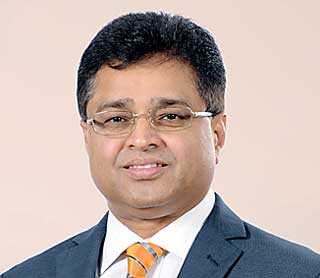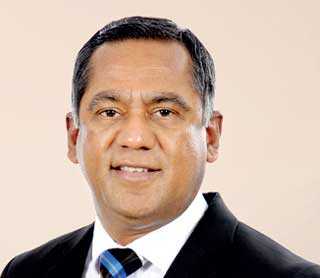Saturday Dec 28, 2024
Saturday Dec 28, 2024
Monday, 18 February 2019 02:19 - - {{hitsCtrl.values.hits}}
Sampath Bank has recorded a Profit before Tax (PBT) of Rs 18.3 b for the year ended 31 December 2018, up by 10.5% against Rs. 16.6 b earned in 2017 after making necessary adjustments as per the SLFRS 9 new accounting standard which required impairment provisioning to be shifted from the incurred credit loss method used previously to the more forward-looking ‘Expected Credit Loss’ method (ECL), which has attracted higher impairment provisions.
 |
Chairman Channa Palansuriya |
 |
Managing Director Nanda Fernando |
This is a significant achievement particularly given the challenging macroeconomic conditions that were seen right throughout the year. Profit after Tax (PAT) too registered a marginal growth of 0.3% from Rs. 12.10 b in 2017 to Rs. 12.14 b in 2018.
Meanwhile the Sampath Bank Group also posted strong results with Group PBT and PAT for the year ended 31 December 2018 reporting Rs. 19.1 b and Rs. 12.6 b respectively, compared to Rs. 17.5 b and Rs. 12.7 b reported for the previous year. Change in Accounting Standard (SLFRS 9) – impact on the last quarter: Although SLFRS 9 was effective from 1 January 2018, the Institute of Chartered Accountants of Sri Lanka issued a Statement of Alternative Treatment (SoAT), granting the option to continue the application of LKAS 39 for the preparation of the interim financial statements.
As permitted by the above SoAT, the bank’s quarterly financial statements for the first three quarters have been prepared based on LKAS 39.
However quarterly financial statements for the fourth quarter have been prepared applying SLFRS 9 and hence the resultant additional provisions have been charged to the fourth quarter.
Fund-Based Income (FBI): Net Interest Income (NII), which accounts for more than 70% of Sampath Bank’s total operating income, touched Rs. 38.1 b in the current year, compared to Rs. 28.4 b reported for 2017. This growth of Rs. 9.7 b (34.2%) was supported by growth in loans and advances coupled with timely re-pricing of the asset and the liability portfolios to overcome the pressure on net interest margins. Furthermore, the bank was able to shed certain large, high cost deposits during the year thanks to approximately Rs. 33 b worth of Tier I and Tier II capital raised during the last quarter of 2017 and in 2018, which in turn helped to improve the NII. Reduction of SRR from 7.5% to 6.0% with effect from 16 November 2018 also had a slight positive impact on NII. The bank managed to improve its NIM from 3.91% in 2017 to 4.41% in 2018.
Non-Fund-Based Income (NFBI): Net fee and commission income, which largely comprises credit, trade, card and electronic channel-related fees, increased to Rs. 9.9 b in 2018, from the Rs. 8.2 b reported in 2017. This notable YoY growth of 21.6% was led by a solid increase in fee-based income generated through credit card operations and innovative value additions, especially electronic channel offerings.
Net gain from financial investments recorded a moderate growth of 10.7%, predominantly due to increase in dividend income earned from financial assets classified as ‘Fair Value through Other Comprehensive Income’ (FVOCI), previously classified as ‘Available for Sale’ (AFS) category.
Other operating income too recorded a YoY increase of 164.8% in 2018, led mainly by an increase in realised exchange income due to the sharp depreciation of the Sri Lankan Rupee against the US Dollar. Consequently, other operating income for 2018 increased to Rs 7.9 b, from Rs. 3 b reported for the year before.
On the other hand, the bank incurred a net trading loss of Rs. 2.3 b as a result of mark to market loss suffered by forward exchange contracts following the Sri Lankan Rupee depreciating by Rs. 29.40 against the USD. As a result, the bank earned a net income of Rs. 5,491 m from its foreign exchange transactions.
Operating expenses: Total operating expenses recorded a growth of 14.1% in 2018, being the consequence of higher personnel expenses resulting from salary increments, increase in other expenses due to higher taxes and inflation, and increase in IT expenses owing to system upgrades, etc. However, it is noteworthy that growth in expenses remained well below the growth in total operating income (34.4%) for the year. This resulted in the Cost to Income Ratio (CIR) improving to end the year at 35.9% as against a CIR of 42.3% for 2017.
Impairment charges: Year 2018 was challenging for the Banking sector as many key sectors of the economy came under pressure. With most businesses seeing poor results right from the start of 2018, all banks including Sampath Bank began to experience non-performing advances growing in the second and third quarters.
Consequently, Sampath Banks’s NPA ratio which stood at 1.64% as at 31 December 2017 went up to 4.25% by end of the third quarter in 2018, prompting immediate action to arrest the situation. Thanks to these proactive measures taken in a timely manner, the bank’s NPA ratio improved from 4.25% as at 30 September 2018 to 3.69% by the end of the financial year 2018.
The impairment charge against individually significant customers also went up from Rs. 1.4 b in 2017 to Rs. 6.1 b for year ended 31 December 2018. The increase in the collective impairment from Rs. 1 b to Rs .4.4 b is partly due to aforementioned portfolio deterioration and partly due to shift in provisioning models from the incurred credit loss method to the expected credit loss (ECL) method as prescribed by SLFRS 9. The additional provisions booked in 2018 against collective impairment due to migration into the ECL method is estimated to be around Rs. 1.9 b.
In addition to recognising collective impairment against loans and advances, SLFRS 9 also requires building up provisions against investments in other banks, investments in debentures, investment in Government securities issued in foreign currency (Sri Lanka Development Bonds, etc.) and financial liabilities such as guarantees, LCs, acceptances and other undrawn loan balances. Accordingly, impairment provision against above categories attracted an additional provision of Rs. 663 m for 2018.
Taxation: Tax expenses continued to rise due to, withdrawal of exemptions granted in Income Tax, etc. Further the Bank was required to pay an additional sum of Rs. 524 m in the last quarter due to introduction of the Debt Repayment Levy (DRL) with effect from 1 October 2018.
Meanwhile total tax expenses on account of FSVAT, NBT, DRL and income tax for 2018 amounted to Rs. 11.1 b, approximately 48% of the bank’s operating profit.
Business growth: Sampath Bank’s total asset base which stood at Rs. 795.1 b as at 31 December 2017 crossed the Rs. 900 b mark for the first time in its history and ended up at Rs. 914.2 b as at the year-end, recording a YoY growth of 15.0%. The bank’s loan growth slowed down during the year predominantly due to low credit demand. Also, with portfolio quality affected as a result of weak economic conditions, the bank began consolidating its activities and gross loans, which stood at Rs. 571.5 b as at 31 December 2017, grew by only Rs. 99 b (17.3%) to reach Rs. 670.3 b by end 2018.
Meanwhile, following a conscious decision to curtail deposit mobilisation activities due to recent capital infusions, Sampath Bank’s deposit base expanded by Rs. 67.6 b (10.7%) during the year to reach Rs. 698.1 b by 31 December 2018. Growth in term deposits (13.7%) outpaced the CASA growth of 5.8% in the year under review resulting in a slight reduction in the bank’s CASA ratio, which stood at 33.4% in 2018 as opposed to 34.9% in 2017.
Performance ratios: Return on Assets (ROA) before income tax for 2018 stood at 2.13%, slightly below 2.29% reported in 2017. The reduction in profitability on account of higher taxes and higher impairment charges discussed above also contributed to the reduction in the ratio. However, despite maintaining the same PAT, Return on Equity (ROE) after income tax declined, from 23.35% in 2017 to 16.02% in 2018, mainly due to the infusion of Rs. 12.5 b to the equity base by way of a Rights Issue in April 2018. The Statutory Liquid Asset Ratio (SLAR) for the Domestic Banking Unit and the Off-Shore Banking Unit were both maintained well above the mandatory requirement of 20% throughout 2018, and ended up at 21.50% and 25.78% respectively as at 31 December 2018.
Capital adequacy: CBSL imposed BASEL III capital adequacy requirements on the Sri Lankan banking industry with effect from 1 July 2017, with the full implementation taking place in three phases over a period of 18 months and completed on 1 January 2019. Therefore, with effect from January 2019, Sampath Bank being a ‘Domestic Systemically Important Bank’ will be required to maintain its Tier I Capital Adequacy Ratio (CAR) at 10% and its Total CAR at 14%.
In order to fall in line with these new regulatory requirements, the bank raised Rs. 7.6 b and Rs. 12.5 b worth of Tier I Capital by way of two Rights Issues in November 2017 and April 2018 respectively. A further Rs. 6 b and Rs. 7.5 b worth of Tier II Capital was raised by way of BASEL III compliant Debenture issues in December 2017 and in March 2018 respectively.
As at 31st December 2018, Sampath Bank maintained its Tier I Capital and Total Capital Adequacy ratios at 12.08% and 15.73% respectively, well above the minimum regulatory requirement of 8.875% (for Tier I) and 12.875% (for Total Capital) respectively applicable as at the reporting date.
The bank has already made an announcement to raise another Rs. 5 b in early 2019 by way of a BASEL III compliant Debenture issue, with an option to go up to Rs. 7 b, to strengthen its Tier II Capital further.
Change in Accounting Standard and day 1 impact: As discussed earlier the new Accounting Standard SLFRS 9 came into effect from 1 January 2018, in place of the previous Accounting Standard LKAS 39 (Financial Instruments: Recognition and Measurement).
Replacing the ‘incurred credit loss’ method prescribed by LKAS 39 in calculating the impairment on financial assets, SLFRS 9 uses the forward looking ‘Expected Credit Loss’ method (ECL). The new standard also introduces a new classification approach for financial assets and financial liabilities in line with the business model in which they are managed and their cash flow characteristics.
SLFRS 9 offers two options, i.e. retrospective method or modified retrospective method, for the preparation of financial statements when adopting the standard for the first time. Being the first year of adoption of the SLFRS 9, Sampath Bank chose the modified retrospective method to prepare financial statements for the year ended 31 December 2018 as the SLFRS 9 allows an entity to restate prior periods if and only if the restatement is possible without the use of hindsight. Under this method the comparative figures are not restated. Instead the standard requires a disclosure of the impact of adopting SLFRS 9 on the Statement of Financial Position and retained earnings showing restated opening balances as at the transition date, 1 January 2018.
Accordingly, the day 1 impact to the bank on implementation of SLFRS 9 amounted to Rs. 2.1 b. Therefore, the retained earnings brought forward from 31 December 2017 which amounted to Rs. 6.1 b was adjusted as at 1 January 2018 by charging Rs. 2.1 b. As a result, the restated retained earnings brought forward as at 1 January 2018 reduced to Rs. 3.9 b.
Dividend: Sampath Bank’s Board of Directors has recommended a final dividend of Rs. 16.25 per share to be paid for the financial year ended 31 December 2018. This will be paid by Rs. 11.25 in the form of scrip dividend and the balance Rs. 5 in the form of cash dividend subject to the approval of the shareholders at the Annual General Meeting to be held on 29 March 2019.